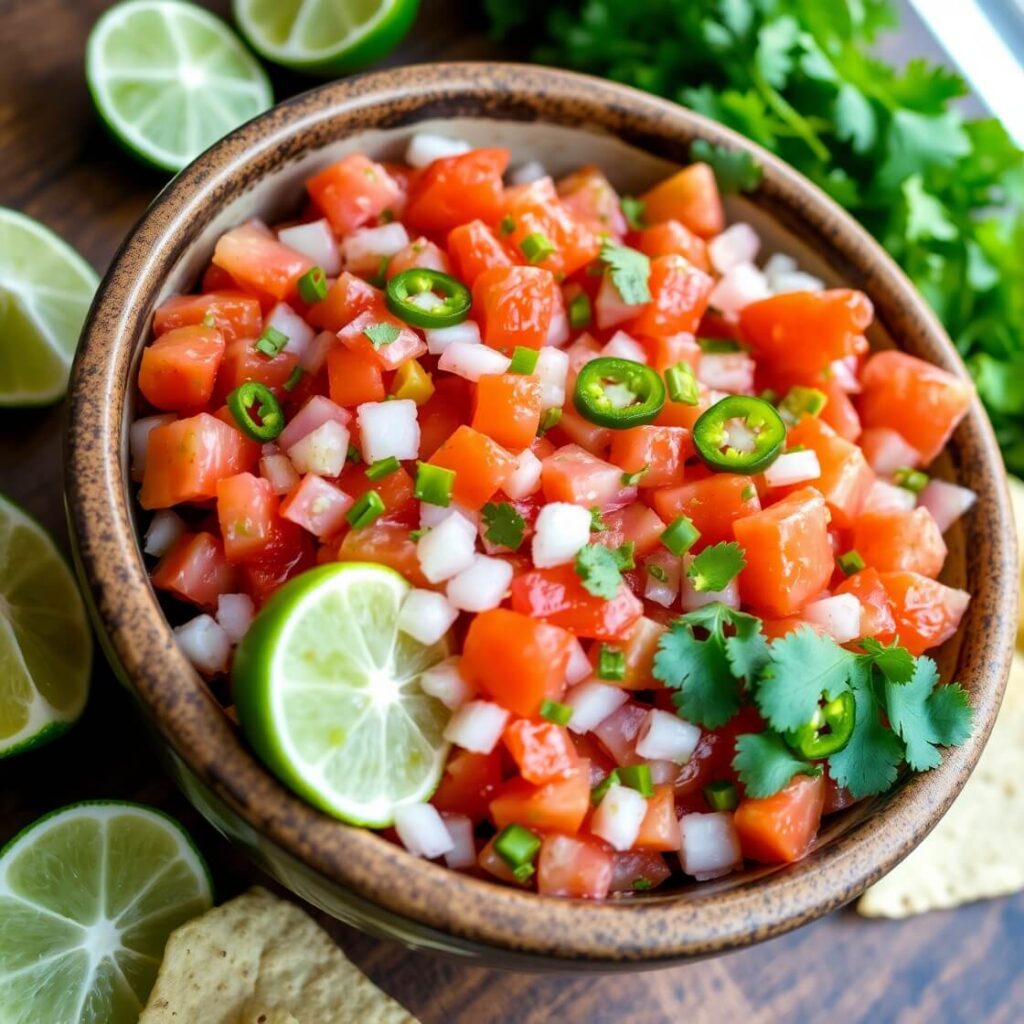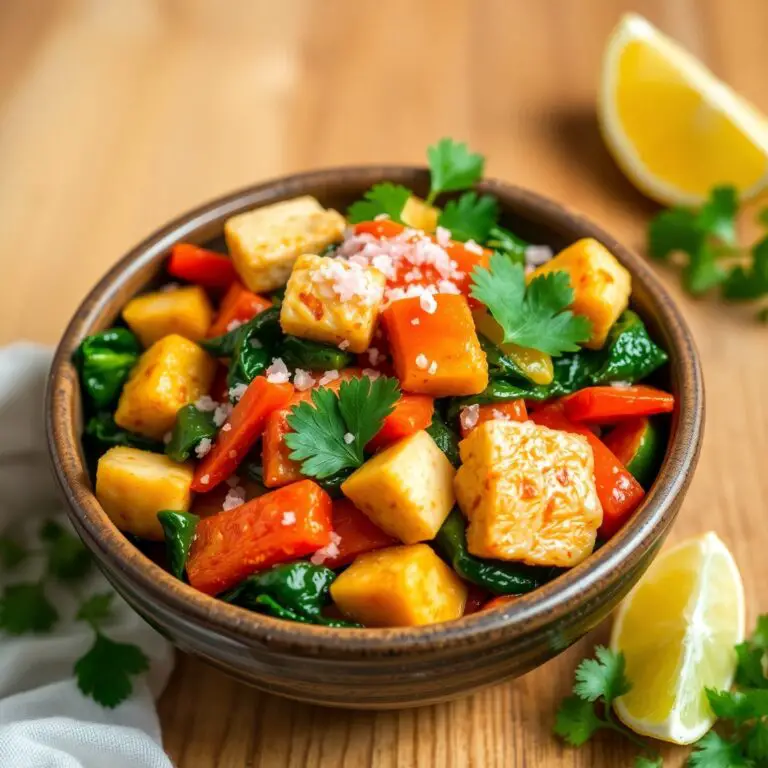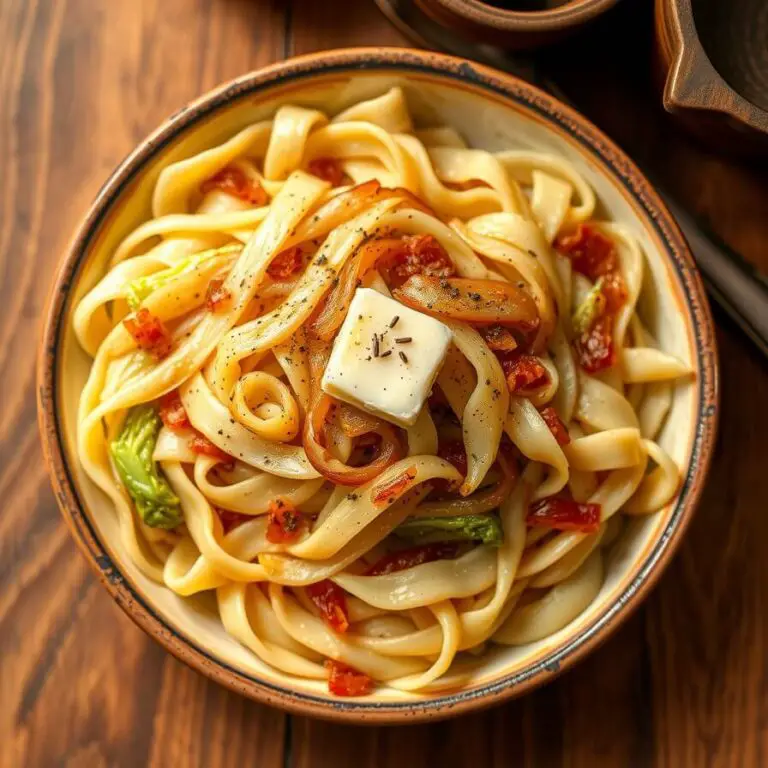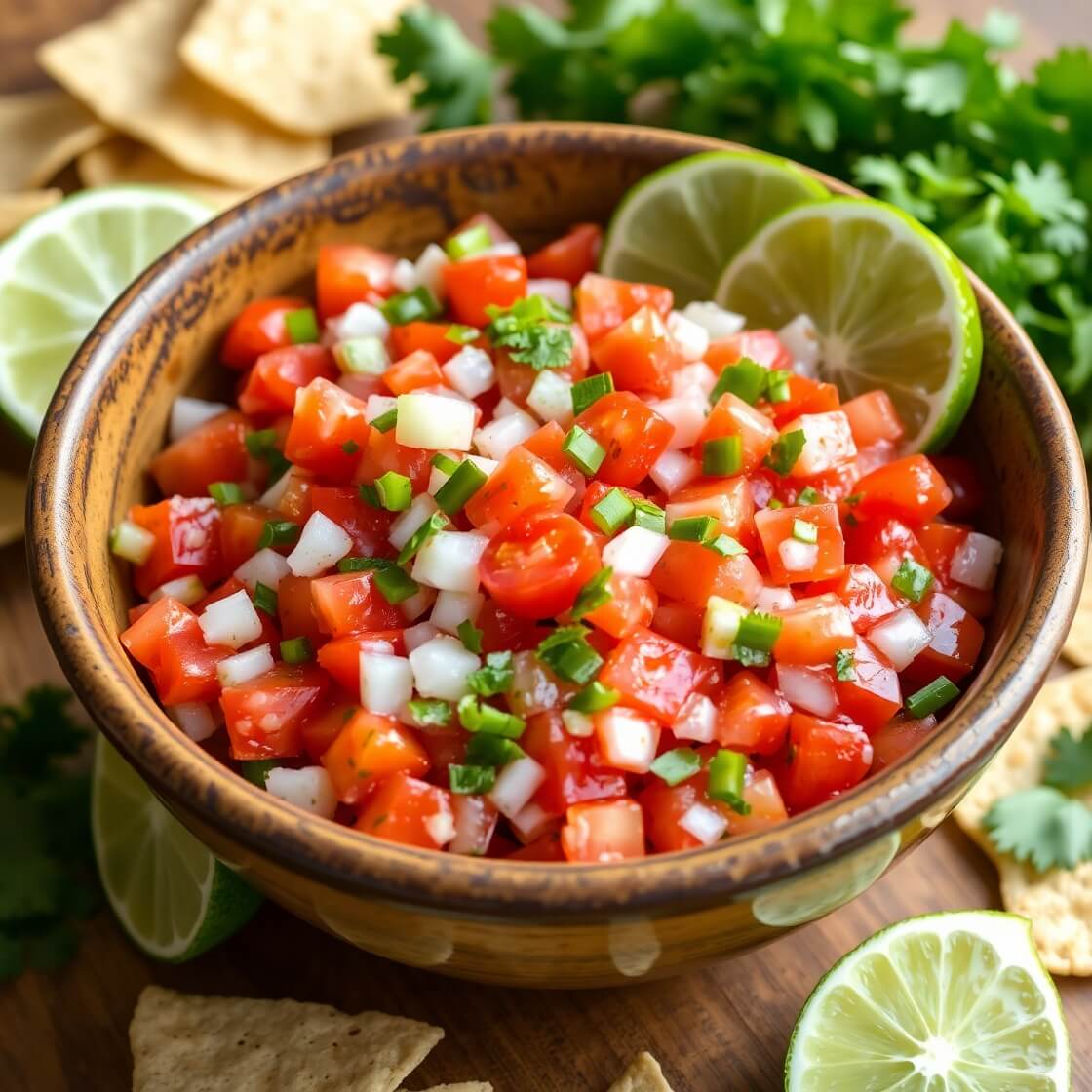
This Pico de Gallo recipe is one of those dishes that never fails to brighten up the table. It’s fresh, vibrant, and full of zesty flavor—and it all started with a family barbecue that needed a little something extra. The grilled chicken was ready, the tortillas were warm, and yet, something was missing. That’s when I decided to throw together a quick bowl of chopped tomatoes, onions, jalapeños, cilantro, and lime juice. From that day forward, it became a staple at every gathering.
Pico de Gallo isn’t just a salsa—it’s an experience. The crunchy texture, the pop of citrus, and the subtle heat all come together in a way that bottled salsa simply can’t replicate. Whether you’re looking to elevate taco night or add a burst of flavor to your eggs in the morning, this recipe is a game-changer.
Why I Love This Recipe
The reason I return to this Pico de Gallo recipe time and time again is simple: it’s incredibly versatile and ridiculously fresh. There’s something deeply satisfying about making a dish with only a handful of ingredients, yet each one brings so much to the table.
What makes this recipe special is how customizable it is. You can dial up the heat or keep it mild. You can make it chunky or finely chopped. You can spoon it over grilled meats, tuck it into wraps, or just scoop it with tortilla chips. No cooking involved—just pure, simple ingredients that shine on their own.
The balance of flavor is what hooks you: acidity from the lime, sharpness from the onion, the sweetness of ripe tomatoes, and the bold herbaceous kick from cilantro. It’s quick to make, healthy, low-calorie, and a staple in so many Mexican and Tex-Mex dishes.
Ingredients for Pico de Gallo
To make the perfect Pico de Gallo, you don’t need fancy tools or hard-to-find ingredients—just a sharp knife, a cutting board, and a love for fresh produce. That’s the beauty of this recipe. It’s proof that simple food can be absolutely unforgettable.
Here’s what you’ll need:
Tomatoes: Use ripe, firm Roma tomatoes. They’re meaty and have fewer seeds and less juice, which helps prevent your pico from turning watery. Make sure they’re deep red and fragrant.
White Onion: This adds the perfect bite. You can use red onion for a slightly sweeter flavor, but white onion brings that authentic Mexican zing.
Jalapeño Pepper: For a bit of heat. You can remove the seeds for a milder version or keep them in if you like it hot. Serrano peppers are another great option if you want more fire.
Fresh Cilantro: It’s not pico without cilantro. Chop it fine so it blends seamlessly into every bite. If you’re one of those who doesn’t like cilantro, flat-leaf parsley is a milder substitute—but fair warning, it won’t be the same.
Lime Juice: Freshly squeezed only. This is the ingredient that ties everything together. It adds that pop of citrus that lifts all the flavors.
Salt: Essential for seasoning and drawing out the juices from the tomatoes and onion.
Optional – Garlic or a dash of cumin: If you want a twist, a tiny bit of minced garlic or ground cumin can deepen the flavor.
That’s it. No oil, no sugar—just real, raw, honest food.
How Much Time Will You Need
This is a recipe that respects your time. You can have it on the table in just 10–15 minutes, depending on how fast you chop.
- Prep time: 10 minutes
- Chill time (optional): 10 minutes to let the flavors meld
- Total time: 10–20 minutes
No cooking, no fancy equipment—just a knife, a bowl, and fresh ingredients.
How to Make This Pico de Gallo
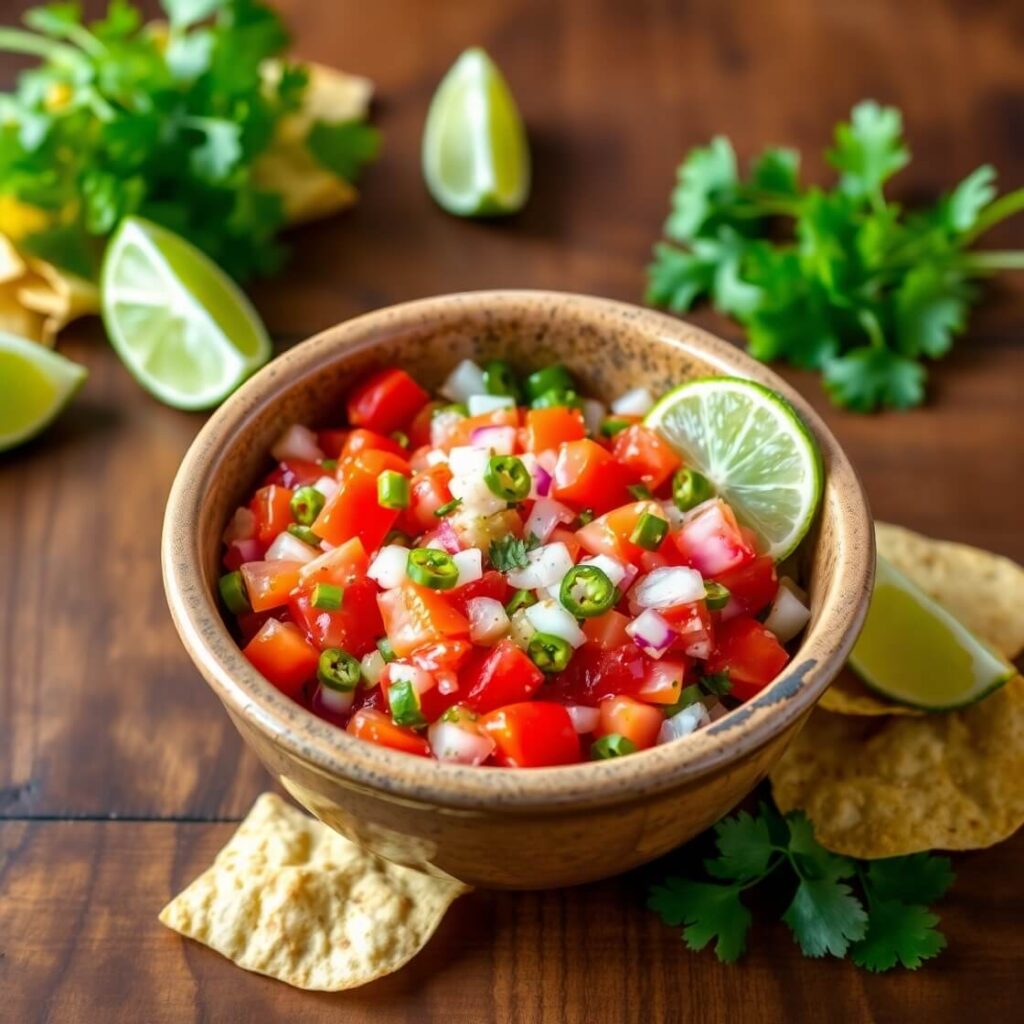
Step – 1: Prep Your Ingredients
Start by washing your produce thoroughly. Pat them dry with a clean towel so no extra moisture dilutes your salsa.
Step – 2: Chop the Tomatoes
Slice the Roma tomatoes in half, scoop out the seeds and pulp (this helps avoid watery pico), and then dice them into small, even pieces. Aim for about ¼-inch cubes for a classic texture.
Step – 3: Dice the Onion
Peel and finely dice your white onion. You can give it a quick rinse under cold water to tame its sharpness, especially if it’s a strong one.
Step – 4: Add Jalapeños
Cut off the stem, slice the jalapeño lengthwise, and remove the seeds if you want less heat. Then dice it finely—smaller is better for heat distribution.
Step – 5: Chop Cilantro
Rinse and dry a handful of fresh cilantro, then chop it finely. Include both the leaves and tender stems; they carry a lot of flavor.
Step – 6: Mix Everything in a Bowl
In a medium bowl, combine your tomatoes, onion, jalapeño, and cilantro. Add a generous squeeze of lime juice and a few pinches of salt.
Step – 7: Taste and Adjust
Mix everything gently, then taste. Want more zing? Add more lime. Not salty enough? Add a touch more salt. Craving heat? Toss in another jalapeño.
Step – 8: Let It Rest (Optional)
Let it sit for 10–15 minutes at room temperature so the flavors can meld. You can also refrigerate it if making ahead.
Step – 9: Serve Fresh
Give it one final stir and serve it up however you like—on tacos, with chips, or spooned over grilled meats.
Substitutions
What I love about Pico de Gallo is that it invites creativity. If you’re short on something or want to experiment, here are some tried-and-true swaps:
Tomatoes: No Roma tomatoes? Cherry tomatoes or grape tomatoes make a great stand-in. Just cut them into quarters or eighths.
Onion: Swap white onion with red onion for a slightly sweeter, colorful variation. Shallots are also a milder option.
Jalapeños: Can’t find fresh jalapeños? Use pickled jalapeños for tang, or try serrano peppers for more heat.
Cilantro: If you’re not a fan of cilantro, try flat-leaf parsley or green onion tops. The flavor won’t be the same, but it’ll still be fresh and vibrant.
Lime Juice: In a pinch, lemon juice will work, though it’ll change the flavor slightly. It’s still fresh and citrusy, though not as traditional.
Want fruit in it? Add finely diced mango, pineapple, or even avocado to make a tropical version.
The key is balance—whatever you substitute, keep the flavor ratios in harmony.
Best Side Dish of Pico de Gallo
Pairing Pico de Gallo with the right dish can elevate your entire meal. Here are three of my go-to sidekicks:
Grilled Street Corn (Elote): The sweetness of the corn, the creaminess of the mayo-cotija topping, and the smokiness from the grill are all enhanced by a spoonful of fresh pico.
Cheesy Quesadillas: A simple cheese quesadilla becomes a flavor bomb when served with a fresh, citrusy salsa on the side. The pico cuts through the richness beautifully.
Black Bean Tacos: Hearty, earthy black beans are the perfect base for bright, acidic pico. Add some crema or avocado and you’ve got a quick, satisfying meal.
Serving and Presentation Tips
There’s something about serving Pico de Gallo that invites people to gather around the table. The colors alone—deep reds, vibrant greens, and flecks of white—make it feel festive and fresh. But it’s not just about taste—it’s about presentation, too.
Serve it in a rustic bowl or a molcajete (a traditional Mexican mortar and pestle made of volcanic stone) for an authentic touch. The rough texture of the stone contrasts beautifully with the glossy tomatoes and crisp onions. If you’re going for a more modern vibe, a white ceramic bowl really makes the colors pop.
Garnish with a lime wedge or two, and scatter a few whole cilantro leaves on top just before serving. Not only does this signal freshness, but it also lets your guests squeeze more lime juice if they want.
Pair with colorful tortilla chips, especially if you’re serving it as an appetizer. Blue corn chips or homemade fried tortilla strips give it that extra special look.
Tips and Tricks to Make This Recipe Better
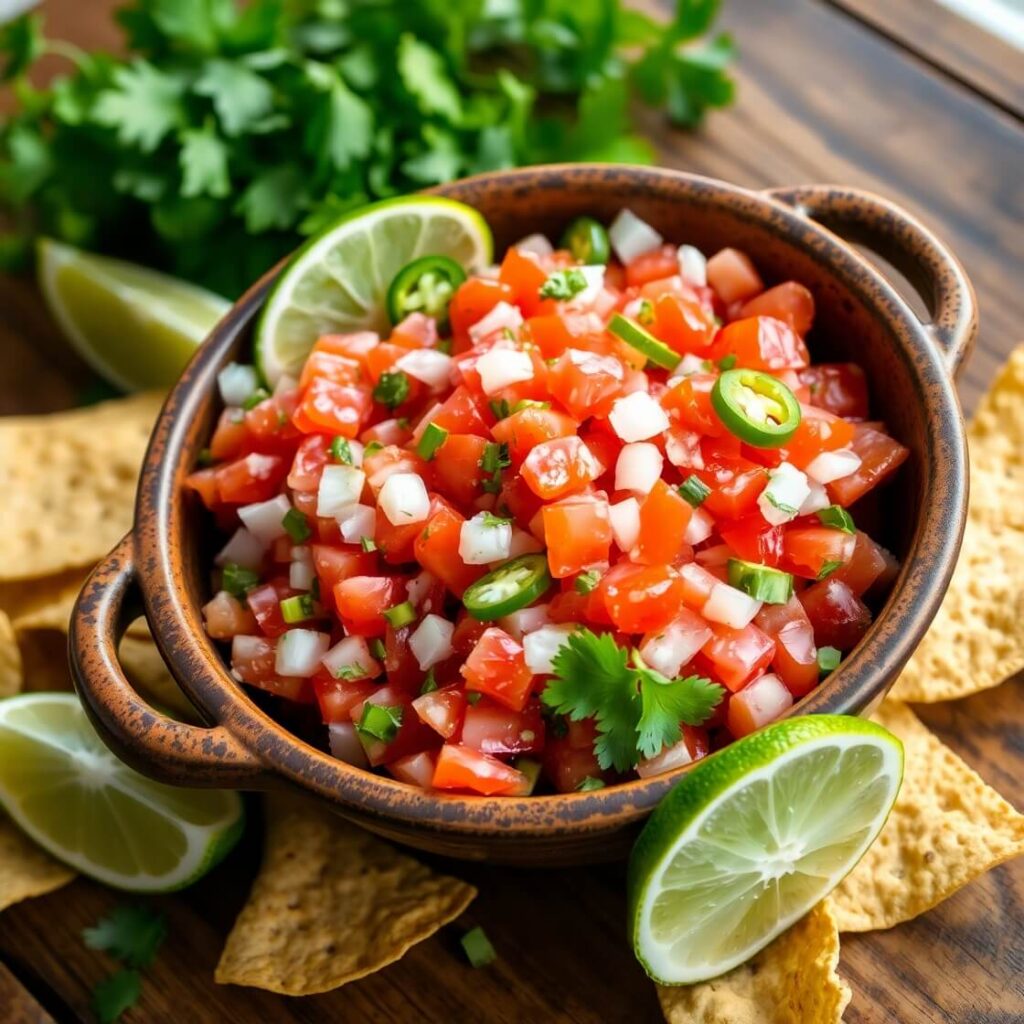
What really sets a great Pico de Gallo apart from a bland one is attention to detail. These tips make all the difference in flavor, texture, and overall experience.
- Use ripe but firm tomatoes. Overripe tomatoes can make the pico watery, while underripe ones lack sweetness. Romas are ideal for their meatiness.
- Remove tomato seeds and pulp. This step prevents your pico from becoming too juicy or soggy. Take an extra minute—it’s worth it.
- Dice everything uniformly. This helps distribute the flavor evenly and makes each bite consistent. A sharp chef’s knife is your best friend here.
- Let it sit before serving. Even just 10–15 minutes allows the lime juice and salt to draw out the juices and create a flavorful marinade.
- Adjust the seasoning after resting. Sometimes the flavors mellow, so give it a taste before serving and add a pinch of salt or another splash of lime if needed.
- Chill it, but not too long. While you can make pico ahead, it’s best enjoyed within a few hours. Overnight storage is fine but will soften the ingredients a bit.
Common Mistakes to Avoid
Even though Pico de Gallo is simple, a few common mistakes can make it fall flat. Avoid these, and you’ll end up with a restaurant-worthy salsa every time.
- Skipping the seed removal from tomatoes. It makes the salsa watery and can drown out the bright flavors.
- Over-chopping or under-chopping. You want small, uniform pieces—not mushy or oversized chunks. Aim for about ¼-inch dice.
- Using bottled lime juice. It just doesn’t have the same zing or complexity as fresh-squeezed lime juice. Always go fresh.
- Adding too much salt too early. The ingredients release water as they sit, which can dilute the seasoning. Start with a pinch and adjust after resting.
- Making it too far in advance. While a short rest enhances flavor, long storage can lead to mushy texture. Make it fresh if you can.
How to Store It
Pico de Gallo is best eaten fresh, but you can store it for short-term use. Here’s how to keep it crisp and flavorful:
- Refrigerate in an airtight container as soon as possible. Glass containers are best—they won’t absorb odors or leach plastic taste.
- Store for up to 2–3 days. After that, the ingredients start to break down and lose their texture.
- Stir before serving. Some liquid will naturally collect at the bottom. Give it a good stir and taste it again before serving—add fresh lime or a pinch of salt if needed.
- Avoid freezing. Freezing alters the texture of fresh ingredients like tomatoes and onions, making them mushy when thawed.
FAQ
Can I make Pico de Gallo ahead of time?
Yes, but it’s best served within a few hours. If making ahead, prep the ingredients and mix them just before serving to retain crunch.
Is Pico de Gallo the same as salsa?
Not quite. Pico de Gallo is a fresh salsa (also called salsa fresca) with chopped raw ingredients. Traditional salsa often includes blended or cooked ingredients and has a more liquid consistency.
Can I make it without cilantro?
You can substitute flat-leaf parsley or just omit it, though cilantro is traditional and gives the dish its authentic flavor.
How spicy is Pico de Gallo?
That depends on how much jalapeño (or serrano) you use. Removing the seeds makes it milder. You can also swap in a bell pepper for zero heat.
What else can I use Pico de Gallo on?
Aside from chips, it’s fantastic on tacos, burrito bowls, grilled meats, scrambled eggs, fish tacos, or even avocado toast.

Pico de Gallo Recipe
- Total Time: 10–15 minutes
- Yield: 2 1x
- Diet: Vegan
Description
A bright and zesty Mexican salsa made with fresh tomatoes, onion, jalapeño, lime juice, and cilantro. This no-cook recipe is perfect for tacos, chips, or spooned over grilled meats. It’s fresh, fast, and full of flavor—everything a homemade salsa should be.
Ingredients
- 4 ripe Roma tomatoes, seeded and finely diced
- ½ medium white onion, finely chopped
- 1 jalapeño, seeds removed and finely diced
- ⅓ cup chopped fresh cilantro
- Juice of 1 lime (about 2 tablespoons)
- ¼ teaspoon salt (or to taste)
Instructions
- Wash and dry all produce.
- Remove seeds and pulp from tomatoes, then dice.
- Finely chop onion, jalapeño, and cilantro.
- Combine all ingredients in a bowl.
- Squeeze in fresh lime juice and sprinkle with salt.
- Mix gently and let sit for 10–15 minutes before serving.
- Taste and adjust seasoning if needed. Serve fresh.
Notes
- For milder heat, use only half a jalapeño or substitute with green bell pepper.
- Add diced mango or avocado for a fun twist.
- For best flavor, don’t skip the resting time—it allows the flavors to meld beautifully.
- Prep Time: 10 minutes
- Cook Time: 0 minutes
- Category: Appetizer / Side
- Method: No-cook
- Cuisine: Mexican
Nutrition
- Serving Size: 2
- Calories: 18
- Sugar: 1.9g
- Sodium: 95mg
- Fat: 0.2g
- Saturated Fat: 0g
- Unsaturated Fat: 0.1g
- Trans Fat: 0g
- Carbohydrates: 3.8g
- Fiber: 1g
- Protein: 0.6g
- Cholesterol: 0mg

